As an Amazon Associate, we earn from qualifying purchases with no additional costs for you.
Carbon steel and stainless steel are common steels used to manufacture knives and other cutting tools. Each steel type has pros and cons, determining which steel is best for the job. Take a look at the differences between each steel to decide which will be best for your knife choice!
Stainless steel and carbon steel have differences in hardness, sharpness, edge retention, ease of sharpening, wear and rust resistance, and level of care required. Both steel types have good and bad qualities, making the best steel the one that performs best for your knife requirements.
Knifemakers and knife owners have for years debated which steel, carbon, or stainless steel is the best steel for knives. Each steel type has a lot going for it to make it the top choice, but both have some problems. Examining the differences between stainless steel and carbon steel will shed light on which is the best steel.
If you are interested in checking out the best Japanese knives made with high-carbon steel we recommend and use you can find them by clicking here (Amazon link). Or if you are interested in checking out the best diamond sharpening stones (Atoma) for stainless knives you can find them by clicking here (Amazon link).

Advantages And Disadvantages Of Carbon Steel Knives
Carbon steels are old steel types that have been around for centuries and perfected over generations of trial and error to create steel superb for making cutting tools.
This long history of carbon steel gives it some advantages in the characteristics that have been developed in the steel.
However, since we do not live in a perfect world, carbon steel also has some negative aspects that make it unsuitable for certain applications.
We will compare the advantages and disadvantages of carbon steel, which will indicate the applications this steel is best suited for.
Advantages Of Carbon Steel For Knives
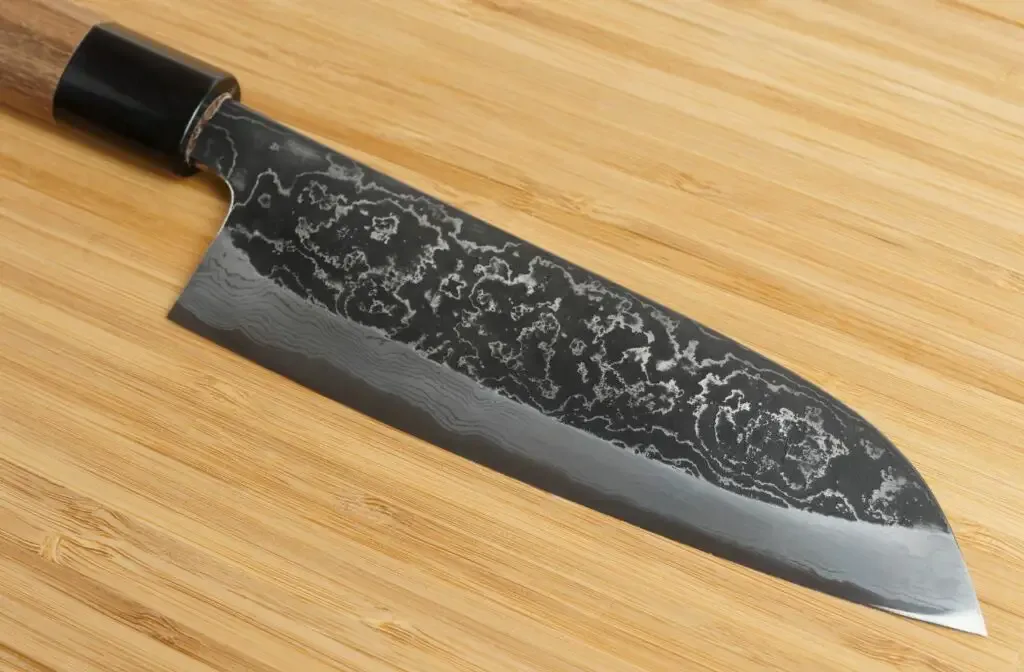
We will begin by examining the advantages of carbon steel, which will indicate why it is still a popular steel today for manufacturing cutting tools.
The advantages of carbon steel include the following.
- Carbon steel is very hard. The molecular structure and combination of alloys in the steel allow high-carbon steel knives to be hardened to a high hardness level. This superior hardness has benefits for the durability of the steel and its edge retention.
- Carbon steel is sharper. Because of the hardness of carbon steel, the cutting edge can be thinner than with other steel. A thinner edge means a sharper edge.
- Stays sharp for longer. Carbon steel is renowned for its superior edge retention over other steel types and is a key reason this steel is chosen for many knives. The edge is durable and not as susceptible to rolling over, dulling the knife.
- Requires less frequent sharpening. Because this steel holds an edge so well, sharpening is required less frequently than other steels. Regular honing of the edge will further extend the time between sharpening sessions.
- Carbon steel is easy to sharpen. Sharpening is a maintenance task that every knife requires from time to time. High carbon steel easily takes an edge, making the sharpening process easier than stainless steel.
Disadvantages Of Carbon Steel For Knives
As we have mentioned, carbon steels are not without their flaws, which can pose some issues when knives are made from this material.
Disadvantages of carbon steel include the following.
- Susceptible to rust. Carbon steel’s susceptibility to rust is probably its biggest disadvantage compared to stainless steel. Carbon steel knives will develop rust very quickly in the presence of moisture or humidity.
- Requires more dedicated care. Carbon steel must be looked after to a greater degree than stainless steel to protect the steel from environmental conditions that can cause rust. Consequently, more care is required for cleaning and storing to protect carbon steel knives.
- Carbon steel stains. While staining is not necessarily a bad thing since the stains, or patina, result in a protective oxidation layer preventing rust, some people do not like this look. If you like your knives shiny, carbon steel is not for you.
- A brittle edge. Carbon steel is hard and can hold a superior edge to stainless steel, but the price for hardness is the steel is brittle. If the knife is dropped or sustains an impact on the cutting edge, the steel can crack or chip, requiring expensive repairs to the knife.
Despite having some disadvantages, carbon steel remains a popular material for creating high-quality, precision-cutting knives!
Why Is Carbon Steel Knife Better Than Stainless?
Whether carbon steel is better than stainless steel or not is largely a matter of circumstance and personal preference.
Circumstance has a large role to play in that certain conditions may favor one type of steel over the other, making it the preferred choice.
Here are some reasons why many people prefer carbon steel knives over stainless steel.
- Better cutting precision. Since carbon steel can be hardened and sharpened to a greater degree than stainless steel, it makes better steel for knives designed for precision cutting work, such as processing ingredients, to enhance the visual appeal of food. As a result, many people prefer carbon steel over stainless steel for kitchen knives.
- Easier to sharpen. Ease of sharpening is one of the main reasons people opt for carbon steel knives, especially as their first knife.
- Edge durability. The stronger edge makes carbon steel knives more suitable for certain knives, such as bushcraft knives used for survival tasks such as batoning firewood, and still retain a sharp edge.
- Cost. Carbon steel is generally cheaper than stainless steel, which allows the purchase of a high-quality carbon steel knife for the same cost as an average stainless steel knife. The notable exception to this is high-carbon steel Japanese kitchen knives, which are very expensive but worth the cost.
TIP: Japan has a long history in the production of steel and manufacturing of superior quality blades. Most of the steel used on Japanese knives is high-carbon steel. Check out all Japanese knife steels in the article below:
Japanese Knives Steel Types (Complete List with Explanation)
Advantages and Disadvantages of Stainless Steel Knives
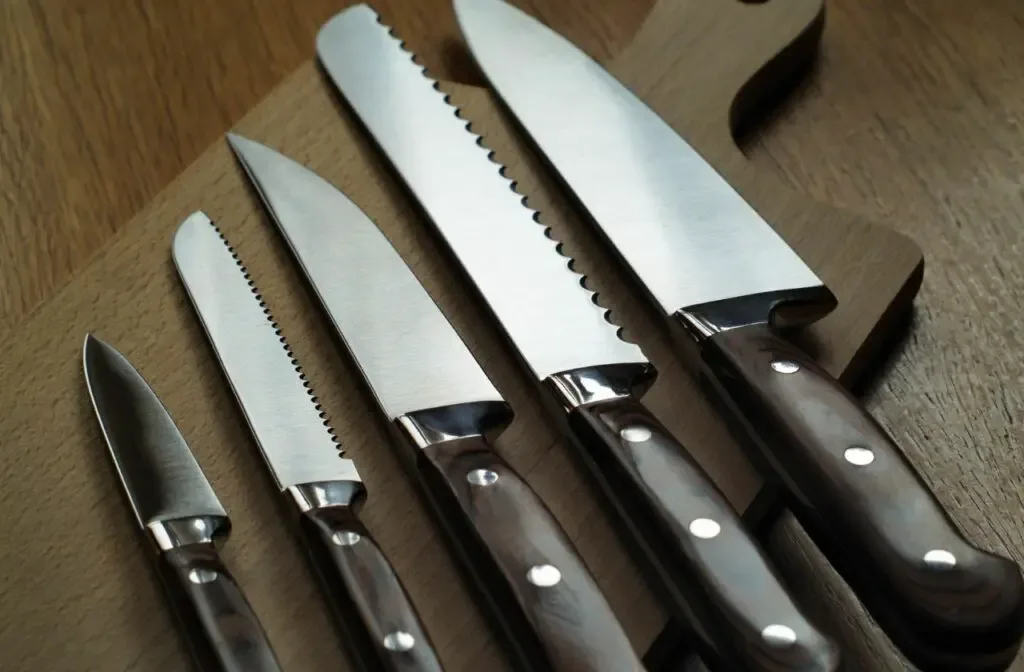
In some circles, stainless steel has become a popular alternative to carbon steel knives. This increased popularity has become more prevalent with the introduction of modern stainless steel, which exhibits many of the characteristics of carbon steel.
Like carbon steel, stainless steel also has disadvantages that convince many people to choose carbon steel over stainless for their knives.
Detailing the advantages and disadvantages of stainless steel will give us a clearer picture of the best applications for this steel type.
Advantages Of Stainless Steel For Knives
- Stainless steel is rust-resistant. The stainless steel composition includes high levels of Chromium, Vanadium, and Molybdenum, which are rust-resistant metals. These metals make stainless steel highly rust-resistant compared to carbon steel. Stainless steel is more resistant to rust development; it is not completely immune.
- Higher wear-resistance. The alloys in stainless steel impart a high level of wear resistance to the steel, making it more durable than carbon steel in this aspect.
- Less care and maintenance are required. Stainless steel’s resistance to rust requires less diligent care and maintenance to care for knives made from this material.
What Are the Cons of Stainless Steel For Knives?
Stainless steel has some great qualities that make it good steel for certain applications, but it is by no means perfect steel.
Some of the cons that detract from the advantages of stainless steel include the following.
- Hard to sharpen. Stainless steel is wear-resistant, but this feature of the steel also makes a stainless steel knife hard to sharpen. The wear resistance makes it difficult for sharpening abrasives to cut the stainless steel to sharpen the cutting edge.
- Stainless steel is softer than carbon steel. Stainless steel won’t harden to the same hardness level as carbon steel, which has implications for stainless steel knives’ edge retention and sharpness.
- Not as sharp as carbon steel. Due to the softer nature of stainless steel, the blade’s cutting edge cannot be made as thin as that of a carbon steel knife. Consequently, a stainless steel knife is not as sharp as a high-carbon steel knife.
- Stainless steel does not stay sharp as long as carbon steel. Since stainless steel is softer than carbon steel, the edge is less robust than carbon steel blades. The edge on a stainless steel knife will roll over more easily, making the knife dull quicker.
These cons for stainless steel may cause you to wonder why we bother with stainless steel at all, but stainless steel knives can be sharpened to shaving-sharp levels and will hold an edge for a long time. However, a carbon steel knife simply does it better.
PRO TIP: We personally use diamond plates by Atoma. They are quite expensive but of the top quality with very long service life.
The initial costs are higher but you have an option of buying replacing diamond skin for all Atoma plates. The costs of replacing diamond skin are much lower than the cost of buying a new diamond plate.
So if you are going to use diamond plates regularly and want to get the best quality on the market, check out the four Atoma diamond plates listed below (Amazon links).
- Atoma Diamond Sharpener Coarse Grade 140 Grit
- Atoma Diamond Sharpener Medium 400 Grit
- Atoma Diamond Sharpener Fine 600 Grit
- Atoma Diamond Sharpener Super Fine 1200 Grit
These 4 diamond sharpening stones are all you need to have for repairing or sharpening your knives.
A Word On Modern Stainless Steel For Knives
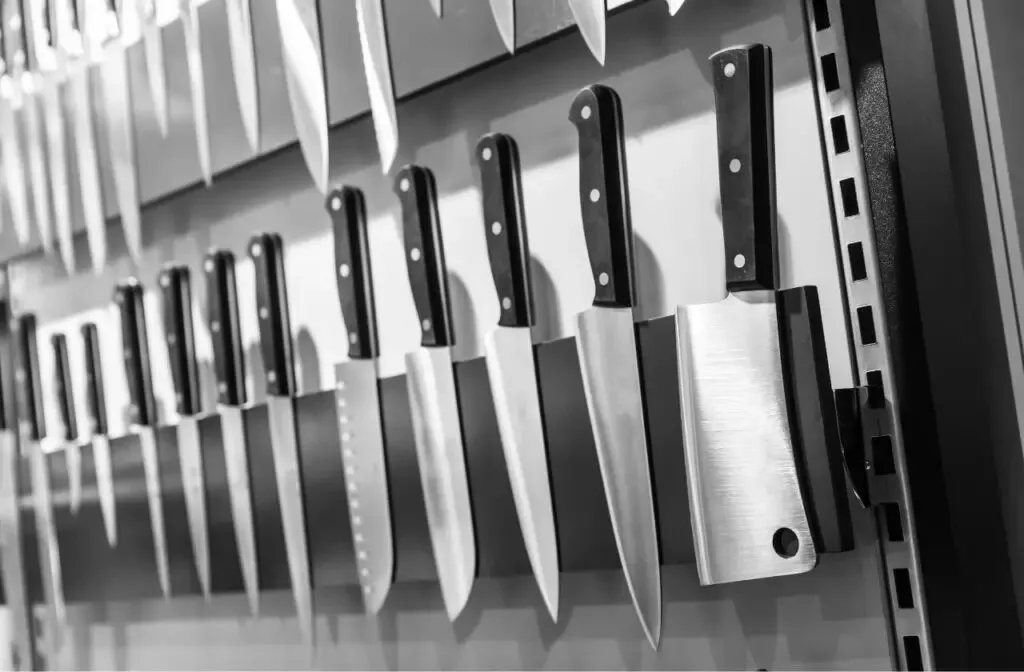
Advances in metallurgy in recent times have seen the development of a higher quality stainless steel, called modern stainless steel or super-steel.
This new form of stainless steel has an alloy composition that gives the steel similar qualities as high carbon steel while retaining the benefits of stainless steel.
You may hear of these steels referred to as high-carbon stainless steel. This steel does not have the same amount of carbon as high-carbon steel, but it has more than traditional stainless steel.
This new steel improves the hardness level, sharpness, and edge retention to closely rival that of carbon steel while still offering the rust and wear resistance of stainless steel.
The biggest obstacle to producing knives from this material is the cost. The techniques used to manufacture this steel are expensive, and it is not made in the same volumes as traditional stainless steel. These factors contribute to making modern stainless steel impractical from a cost point of view for knife making.
TIP: Stainless steel knives quickly gained the reputation of being difficult to sharpen. Check out the step-by-step guide on how to sharpen stainless steel knives in the article below:
DIY Guide: Best Way To Sharpen A Stainless Steel Knife
Should Knives be Stainless Steel?
While carbon steel is popular, stainless steel is growing in popularity, particularly with improvements in the quality of stainless steel.
Stainless steel knives excel in environments where carbon steel knives will not withstand harsh conditions. High humidity, harsh chemicals, high salt, and heat environments would be severely detrimental to carbon steel blades.
The wear, stain, and rust resistance of stainless steel makes it ideal for use in these conditions and environments.
For many people, the overriding factor in choosing stainless steel is the lower care and maintenance required to keep the knife in good condition. Stainless steel may be more difficult to sharpen than carbon steel, but the benefits may result in this being an insignificant downside for many people.
Differences Between Carbon Steel And Stainless Steel Knives
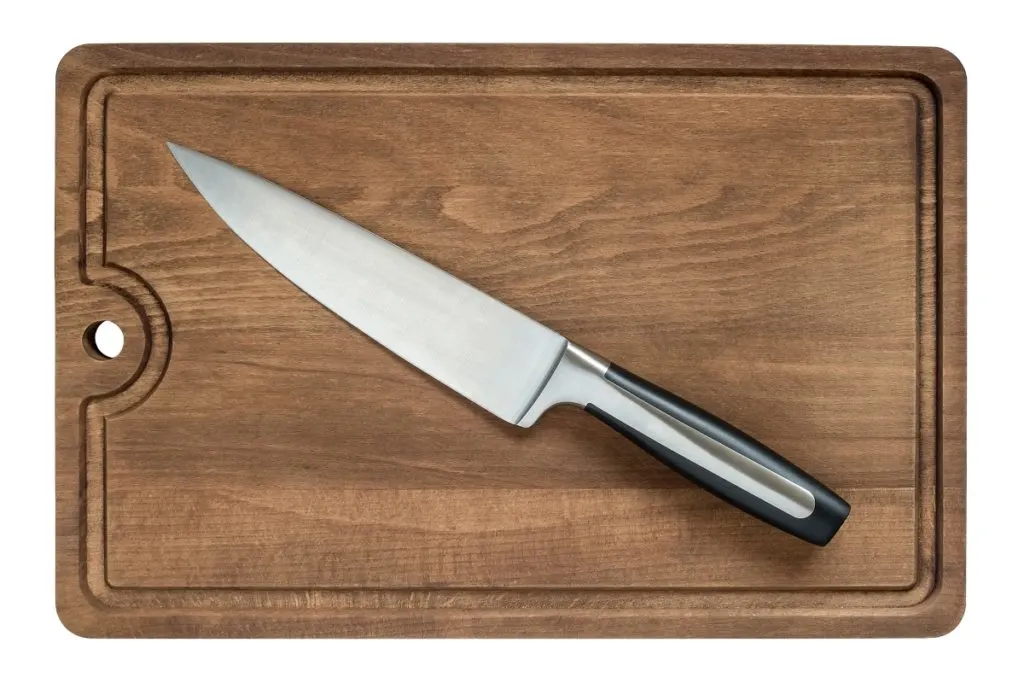
We have covered the advantages and disadvantages of stainless and carbon steel, but you may still be on the fence in deciding which would be better for your knife choice.
The main differences between the two steel types are as follows.
- The hardness of the steel. Carbon steel comes out tops here.
- Level of sharpness. Carbon steel wins this category.
- Edge retention capability of the steel. Carbon steel holds an edge better.
- Brittleness of the steel. Carbon steel loses here since brittleness is not a desirable quality.
- Potential for rolling of the edge, causing dullness of the knife. Stainless steel is more likely to roll the edge, which is undesirable.
- Rust resistance. Stainless steel wins this category hands down
- Stain resistance. Stainless steel resists staining.
- Chemical resistance. Stainless steel is less affected by harsh chemicals and substances.
- Wear resistance. Stainless steel is more wear-resistant than carbon steel
- Ease of sharpening. Carbon steel is easier to sharpen
- Level of maintenance required. Carbon steel is more maintenance-intensive.
- Suitability for a beginner knife owner. A carbon steel knife is more suitable for a beginner.
It would be beneficial to compare the differences between these two steel types side by side to give an easy visual comparison to help in your decision-making.
Differences Between Stainless Steel And Carbon Steel Knives (Score out of 5):
| Feature | Stainless Steel | Carbon Steel |
|---|---|---|
| Hardness | ★★★ | ★★★★★ |
| Sharpness | ★★★★ | ★★★★★ |
| Edge retention | ★★★ | ★★★★ |
| Cracking and chipping | ★ | ★★★★ |
| Edge rollover | ★★★★ | ★ |
| Resistance to rust | ★★★★★ | ★ |
| Stain resistance | ★★★★★ | ★★ |
| Chemical resistance | ★★★★★ | ★ |
| Wear resistance | ★★★★★ | ★★★ |
| Ease of sharpening | ★★★ | ★★★★★ |
| Level of maintenance required | ★ | ★★★★ |
| Best for beginner | ★★★ | ★★★★ |
The conclusion we can form from this data is that both steel types have their strengths where they excel over the other and weaknesses that make them unsuitable for certain applications.
TIP: Many knives are produced with a blackened blade, while others blacken or darken over time. Check out proven tips on how to blacken a knife by yourself in the article below:
3 Proven Ways On How To Blacken A (Stainless) Knife Blade
Do Chefs Use Stainless Steel Or Carbon Steel Knives?
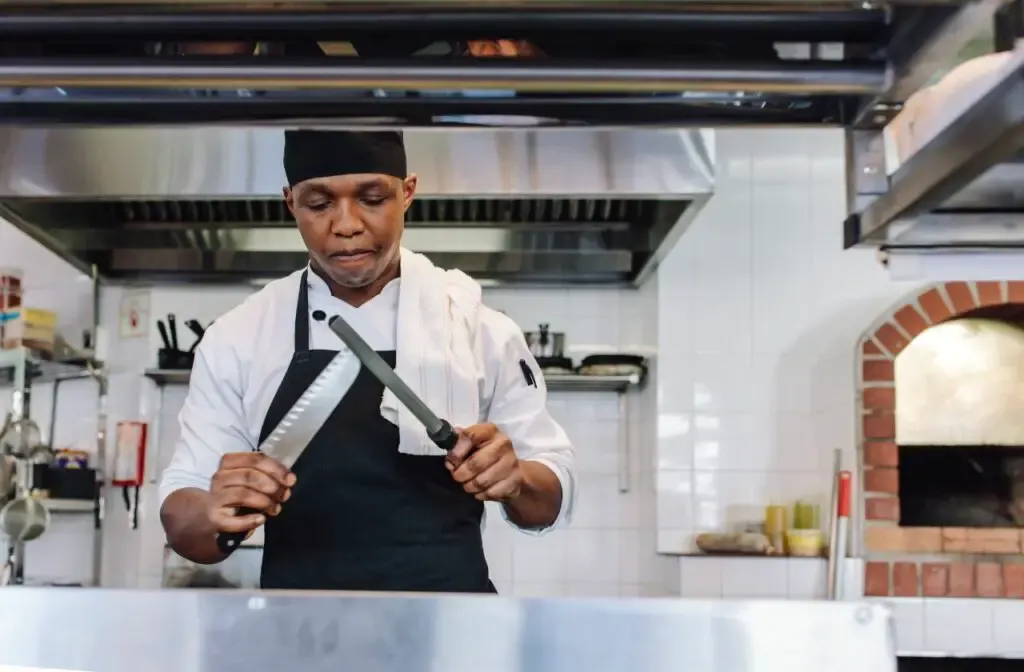
Chefs, particularly professional chefs, will use the best knife for the job at hand. Consequently, chefs will choose their knives based on the type of food they prepare, the environment they work in, and personal preferences.
Chefs use both stainless steel and high-carbon steel knives, but they may prefer one or the other for certain tasks depending on the cuisine they specialize in and the type of knife they enjoy working with the most. Chefs will have a mix of knives, but specialty knives will mostly be carbon steel.
Consequently, you will not often find a chef sticking to only using stainless or only using carbon steel knives.
BTW: If you want to know more about Japanese and other knives and their sharpening, check out the books listed above. These books are recommended by professional sharpeners and knife makers (Amazon links):
- Japanese Kitchen Knives: Essential Techniques and Recipes
- The Knifenerd Guide to Japanese Knives
- Knife: The Culture, Craft, and Cult of the Cook’s Knife
- Sharp: The Definitive Introduction to Knives, Sharpening, and Cutting Techniques, with Recipes from Great Chefs
Which Type Of Knife Is Better For You?
When it comes to choosing between stainless steel and high-carbon steel knives, the decision often boils down to individual preferences and specific use cases.
Both types of knives have their unique strengths and weaknesses. Let’s delve into the differences between these two popular knife materials to help you make an informed choice.
The best knife for you depends on your specific needs, preferences, and the tasks you’ll be using the knife for. Both stainless steel and high-carbon steel knives have their merits.
Evaluate what’s more important to you: the longevity and sharpness of high-carbon steel or the durability and low maintenance of stainless steel. Once you’ve made your choice, ensure you care for your knife appropriately to maximize its lifespan and performance.
Stainless Steel Knives
Stainless steel knifes are less prone to rusting compared to carbon steel blades, due to high levels of Chromium, Vanadium, and Molybdenum.
These knives require less diligent care, making them ideal for those who might not have the time for regular knife maintenance. Stainless steel knives might not achieve the same razor-sharp edge as high-carbon steel knives.
Knife blades made from stainless steel are more resistant to wear and staining, ensuring they maintain their appearance over time, however, they tend to lose their sharpness faster than high-carbon steel knives, and stainless steel knives can be harder to sharpen due to wear resistance.
High-Carbon Steel Knives
High-carbon steel knives can be honed to a finer edge, making them exceptionally sharp, and they are renowned for retaining their sharpness for extended periods.
These knives are also possess exceptionally hard blades. Despite this hardness, high-carbon steel knives are relatively easier to sharpen. However, such high hardness can make them more susceptible to chipping or cracking upon impact.
High-carbon steel knives demand more dedicated care to protect against environmental factors, as they can rust quickly when exposed to moisture or humidity.
Making Your Choice
If you’re a professional chef or someone who values precision in cutting, a high-carbon steel knife might be more suitable due to its sharpness and edge retention.
If you’re looking for a knife that requires minimal maintenance and is durable for everyday kitchen tasks, a stainless steel knife might be the better choice.
If you’re an adventurer who needs a knife for outdoor activities in varying conditions, stainless steel’s rust resistance might be more beneficial.High-carbon steel knives, especially those of Japanese make, can be more expensive. If you’re on a budget but still want a quality knife, consider the cost-to-benefit ratio of each type.
[Verdict] Which One is Better: Carbon or Stainless Steel Knife?
Determining whether stainless or carbon steel knives are better is an almost impossible task since both steel types produce high-quality knives suitable for different circumstances.
To establish which knife would be best for your purposes, you need to evaluate your needs and what you require in a knife. If you are a beginner knife owner, we recommend going with a carbon steel knife.
It will be easier to sharpen, and the extra care required to keep the knife in good condition will teach you valuable knife-care lessons.
TIP: Diamond sharpening stones are a great option for stainless steel knives. Check out the ultimate guide on how to use diamond sharpening stones in the article below:
DIY Guide: Using Diamond Knife Sharpening Stone Like A PRO

